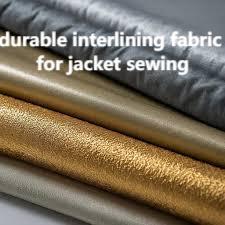In contemporary fashion manufacturing, mastering the balance between aesthetic appeal and structural integrity is vital. A well-chosen Interlining layer inserted between fabric panels can dramatically improve shape retention and comfort. By providing targeted support where needed, this core component prevents unwanted stretching and adds body to collars, cuffs, and waistbands, all without compromising the garment’s natural drape.
Understanding Fabric Reinforcement Techniques
Achieving consistent support begins with selecting the right reinforcement method. Woven variants, crafted much like traditional fabrics, offer dimensional stability for sharp edges and defined silhouettes. Non‑woven options—bonded through mechanical, thermal, or chemical processes—deliver a smooth finish, ideal for streamlined dress shirts and lightweight jackets. For garments requiring flexibility, knit constructions stretch in one or more directions, accommodating movement while maintaining form.
Heat-Activated vs. Stitch-In Applications
Production workflows often dictate whether to use heat‑activated layers or stitch‑in patches. Thermal bonding allows rapid adhesion during pressing, accelerating high‑volume manufacturing lines. Conversely, sew‑in support requires manual stitching, granting precision placement on delicate fabrics that cannot tolerate elevated temperatures. Both techniques have their place in the design spectrum, from mass‑market staples to bespoke couture pieces.
Material Innovation and Comfort
Modern support fabrics incorporate novel fibers and blends. Polyester and nylon offer durability and resilience, while cotton‑based blends prioritize breathability. Manufacturers explore eco‑friendly alternatives—such as recycled fibers and bio‑based polymers—to meet growing sustainability demands. Layer thickness, fiber density, and hand‑feel combine to create comfort without bulk, ensuring wearers enjoy both style and functionality.
Performance Testing and Quality Control
Rigorous assessment protocols guarantee that every batch meets performance requirements. Peel‑strength tests measure adhesion durability, while wash‑fastness trials ensure support layers withstand repeated laundering. Hand‑feel evaluations certify that the added layer remains imperceptible to the wearer. Quality control teams track these metrics, safeguarding consistency and brand reputation.
Future Directions in Garment Engineering
The intersection of textile science and wearable technology points to exciting possibilities. Researchers investigate phase‑change materials for temperature regulation, conductive fibers for integrated sensors, and 3D‑knitted structures for seamless garment construction. These innovations promise to elevate both performance and wearer experience, positioning support layers as key enablers of next‑generation apparel.
In summary, the strategic use of support layers transforms ordinary fabrics into high‑performance garments. Understanding the variety of materials, application methods, and testing standards empowers designers and manufacturers to create clothing that looks impeccable, feels comfortable, and stands the test of time. For more detailed insights into applications and materials, visit:
https://www.interlining-factory.com/news/what-is-interlining-types-applications-and-more.html




